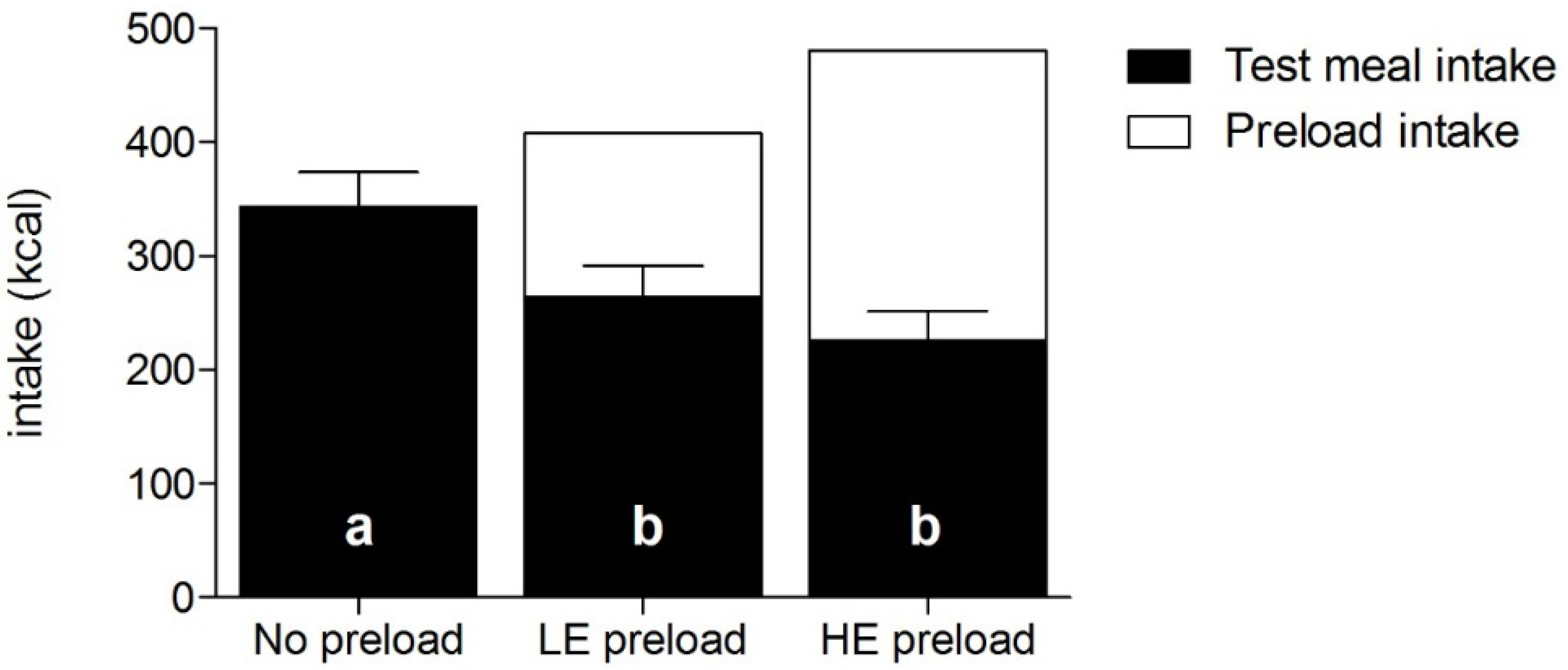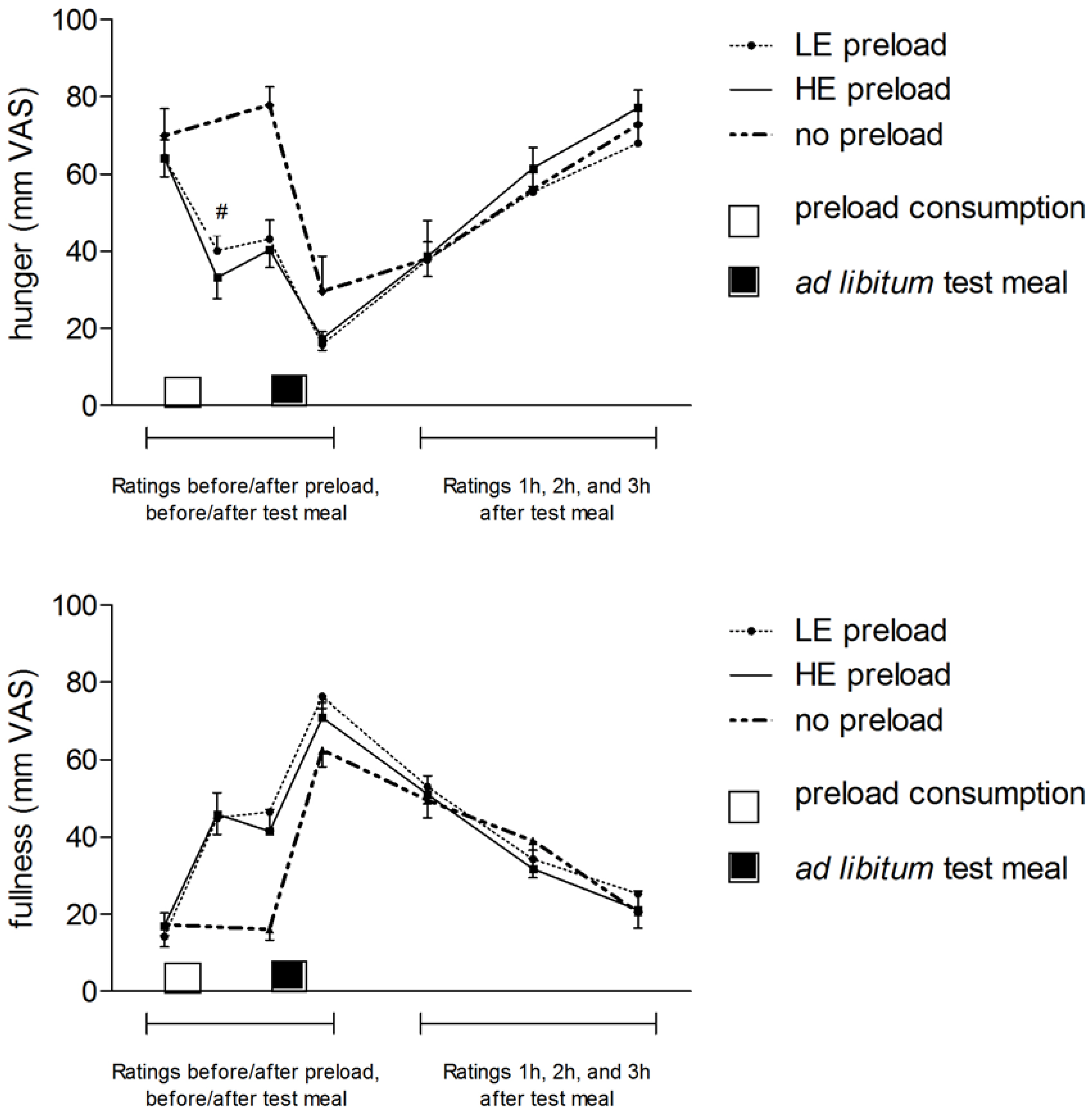Are You Sure? Confidence about the Satiating Capacity of a Food Affects Subsequent Food Intake
Abstract
:1. Introduction
2. Methods
2.1. Design and Subjects
2.2. Test Foods
| Ingredients (g/100 g) | Low energy density (53 kcal/100 g) | High energy density (94 kcal/100 g) |
|---|---|---|
| Low-fat mild yogurt | 33 | - |
| High-fat mild yogurt | - | 24 (23.8) |
| Water | 27 (26.8) | 27 (27.1) |
| Semi-skimmed milk | 8.6 | 8.7 |
| Banana | 8.6 | 8.7 |
| Frozen strawberries | 8.6 | 8.7 |
| Cream Cheese (9% fat) | 8.6 | 5.8 |
| Angel Delight strawberry flavor | 1.7 | 1.7 |
| Hartley’s Jelly strawberry flavor | 1.3 | 1.3 |
| Lemon juice | 1.3 | 1.7 |
| Benefiber powder | 1.0 | 1.1 |
| Stevia sweetener | 0.6 | 0.2 |
| Maltodextrin | - | 11.3 |
| Sensory characteristics * | ||
| Sweet | 75 ± 19 | 75 ± 17 |
| Creamy | 54 ± 21 | 50 ± 22 |
| Thick | 27 ± 25 | 25 ± 21 |
| Filling | 24 ± 16 | 25 ± 23 |
| Liking | 48 ± 24 | 44 ± 23 |
2.3. Procedures
2.4. Data Analysis
3. Results


4. Discussion
5. Conclusions
Acknowledgments
Author Contributions
Conflicts of Interest
References
- Brunstrom, J.M.; Rogers, P.J. How many calories are on our plate? Expected fullness, not liking, determines meal-size selection. Obesity 2009, 17, 1884–1890. [Google Scholar] [CrossRef] [PubMed]
- Wilkinson, L.L.; Hinton, E.C.; Fay, S.H.; Ferriday, D.; Rogers, P.J.; Brunstrom, J.M. Computer-based assessments of expected satiety predict behavioural measures of portion-size selection and food intake. Appetite 2012, 59, 933–938. [Google Scholar] [CrossRef] [PubMed]
- Bilman, E. Claiming Satiety: Consumer Perception, Interpretation and Subsequent Food Intake. Doctoral Dissertation, The Wageningen University, Wageningen, The Netherlands, 26 February 2014. [Google Scholar]
- Hogenkamp, P.S.; Stafleu, A.; Mars, M.; Brunstrom, J.M.; de Graaf, C. Texture, not flavor, determines expected satiation of dairy products. Appetite 2011, 57, 635–641. [Google Scholar] [CrossRef] [PubMed]
- McCrickerd, K.; Chambers, L.; Brunstrom, J.; Yeomans, M. Subtle changes in the flavour and texture of a drink enhance expectations of satiety. Flavour 2012, 1, 20. [Google Scholar] [CrossRef]
- Yeomans, M.R.; Chambers, L. Satiety-relevant sensory qualities enhance the satiating effects of mixed carbohydrate-protein preloads. Am. J. Clin. Nutr. 2011, 94, 1410–1417. [Google Scholar] [CrossRef] [PubMed]
- Yeomans, M.; McCrickerd, K.; Brunstrom, J.M.; Chambers, L. Effects of repeated consumption on sensory-enhanced satiety. Brit. J. Nutr. 2013, 111, 1137–1144. [Google Scholar] [CrossRef] [PubMed]
- Hogenkamp, P. The effect of sensory-nutrient congruency on food intake after repeated exposure: Do texture and/or energy density matter? Physiol. Behav. 2014, 136, 86–90. [Google Scholar] [CrossRef] [PubMed]
- Cassady, B.A.; Considine, R.V.; Mattes, R.D. Beverage consumption, appetite, and energy intake: What did you expect? Am. J. Clin. Nutr. 2012, 95, 587–593. [Google Scholar] [CrossRef] [PubMed]
- Crum, A.J.; Corbin, W.R.; Brownell, K.D.; Salovey, P. Mind over milkshakes: Mindsets, not just nutrients, determine ghrelin response. Health Psychol. 2011, 30, 424–429. [Google Scholar] [CrossRef] [PubMed]
- Hogenkamp, P.S.; Cedernaes, J.; Chapman, C.D.; Vogel, H.; Hjorth, O.C.; Zarei, S.; Lundberg, L.S.; Brooks, S.J.; Dickson, S.L.; Benedict, C.; et al. Calorie anticipation alters food intake after low-caloric not high-caloric preloads. Obesity 2013, 21, 1548–1553. [Google Scholar] [CrossRef] [PubMed]
- Provencher, V.; Polivy, J.; Herman, C.P. Perceived healthiness of food. If it’s healthy, you can eat more! Appetite 2009, 52, 340–344. [Google Scholar] [CrossRef] [PubMed]
- Faulkner, F.P.; Pourshahidi, L.K.; Wallace, J.M.; Kerr, M.A.; McCaffrey, T.A.; Livingstone, M.B. Perceived “healthiness” of foods can influence consumers’ estimations of energy density and appropriate portion size. Int. J. Obes. 2014, 38, 106–112. [Google Scholar] [CrossRef] [PubMed]
- Brunstrom, J.M.; Shakeshaft, N.G.; Alexander, E. Familiarity changes expectations about fullness. Appetite 2010, 54, 587–590. [Google Scholar] [CrossRef] [PubMed]
- Cappelleri, J.; Bushmakin, A.; Gerber, R.; Leidy, N.; Sexton, C.; Lowe, M.; Karlsson, J. Psychometric analysis of the Three-Factor Eating Questionnaire-R21: Results from a large diverse sample of obese and non-obese participants. Int. J. Obes. 2009, 33, 611–620. [Google Scholar] [CrossRef] [PubMed]
- Robinson, E.; Aveyard, P.; Daley, A.; Jolly, K.; Lewis, A.; Lycett, D.; Higgs, S. Eating attentively: A systematic review and meta-analysis of the effect of food intake memory and awareness on eating. Am. J. Clin. Nutr. 2013, 97, 728–742. [Google Scholar] [CrossRef] [PubMed]
- Hardman, C.; Ferriday, D.; Kyle, L.; Rogers, P.J.; Brunstrom, J.M. So many brands and varieties to choose from: Does this compromise the control of food intake in humans? PLoS ONE 2015, 10, e0125869. [Google Scholar] [CrossRef] [PubMed]
- Almiron-Roig, E.; Palla, L.; Guest, K.; Ricchiuti, C.; Vint, N.; Jebb, S.A.; Drewnowski, A. Factors that determine energy compensation: A systematic review of preload studies. Nutr. Rev. 2013, 71, 458–473. [Google Scholar] [CrossRef] [PubMed]
- Rolls, B.J. The relationship between dietary energy density and energy intake. Physiol. Behav. 2009, 97, 609–615. [Google Scholar] [CrossRef] [PubMed]
- Brunstrom, J.M.; Shakeshaft, N.G.; Scott-Samuel, N.E. Measuring “expected satiety” in a range of common foods using a method of constant stimuli. Appetite 2008, 51, 604–614. [Google Scholar] [CrossRef] [PubMed]
© 2015 by the authors; licensee MDPI, Basel, Switzerland. This article is an open access article distributed under the terms and conditions of the Creative Commons Attribution license (http://creativecommons.org/licenses/by/4.0/).
Share and Cite
Schiöth, H.B.; Ferriday, D.; Davies, S.R.; Benedict, C.; Elmståhl, H.; Brunstrom, J.M.; Hogenkamp, P.S. Are You Sure? Confidence about the Satiating Capacity of a Food Affects Subsequent Food Intake. Nutrients 2015, 7, 5088-5097. https://doi.org/10.3390/nu7075088
Schiöth HB, Ferriday D, Davies SR, Benedict C, Elmståhl H, Brunstrom JM, Hogenkamp PS. Are You Sure? Confidence about the Satiating Capacity of a Food Affects Subsequent Food Intake. Nutrients. 2015; 7(7):5088-5097. https://doi.org/10.3390/nu7075088
Chicago/Turabian StyleSchiöth, Helgi B., Danielle Ferriday, Sarah R. Davies, Christian Benedict, Helena Elmståhl, Jeffrey M. Brunstrom, and Pleunie S. Hogenkamp. 2015. "Are You Sure? Confidence about the Satiating Capacity of a Food Affects Subsequent Food Intake" Nutrients 7, no. 7: 5088-5097. https://doi.org/10.3390/nu7075088
APA StyleSchiöth, H. B., Ferriday, D., Davies, S. R., Benedict, C., Elmståhl, H., Brunstrom, J. M., & Hogenkamp, P. S. (2015). Are You Sure? Confidence about the Satiating Capacity of a Food Affects Subsequent Food Intake. Nutrients, 7(7), 5088-5097. https://doi.org/10.3390/nu7075088






